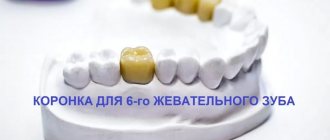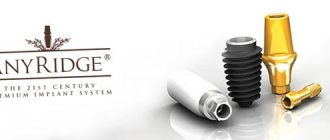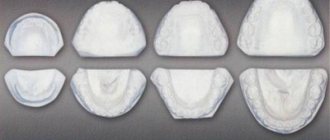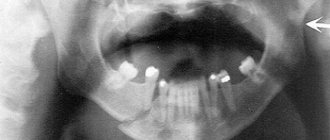Chewing teeth, or as people say, back teeth, are the most important elements of the dentition. They are the ones who actively participate in the process of chewing food. Chewing teeth are much stronger than the front teeth, but caries most often develop on them. This is explained by the fact that when chewing food, pathogenic bacteria accumulate around them in large quantities, causing caries. In addition, it is the chewing units of the dentition that are subject to the greatest stress.
Untreated caries can lead to pulpitis or periodontitis and cause tooth loss. And the loss of even one chewing tooth is fraught with the most negative consequences for human health as a whole.
In the absence of a chewing tooth, the correct distribution of the load is disrupted; it falls in excess on healthy teeth, which leads to their rapid wear. Food begins to be chewed poorly, and this is already dangerous for the development of gastrointestinal pathologies. In addition, in the absence of chewing teeth, aesthetic problems such as sagging facial contours, premature appearance of wrinkles, and the formation of deep nasolabial folds may also appear.
All these unpleasant consequences can be prevented - you need to go to the dentist and restore lost chewing teeth. Restoration of chewing teeth can be carried out with classic prosthetics or with a more modern technology - implantation.
We will tell you about implantation of chewing teeth in this article. After reading the material, you will learn about the features of implantation of chewing teeth, what implants and crowns need to be placed in order to get a durable and reliable result. Also in the article you will find photos of the results before and after, read reviews about implantation of chewing teeth, and learn about prices for the service in Moscow.
Take a short test and calculate the cost of treatment!
Take a short test
- Selection of implants
- Which tooth is missing?
- How long has the tooth been lost?
- Missing teeth
- Cost calculation
×
Manukyan Artavazd Genrikovich
Chief physician of the clinic
Price
- Primary appointment (examination, consultation) with a dentist (special offer) 100001
For free
Promotion
- SGS implant + turnkey crown
24 900 ₽
Promotion
- Osstem implant + turnkey zirconium crown
29 900 ₽
Promotion
- Astra Tech implant + turnkey zirconium crown
59 900 ₽
Promotion
- Nobel implant + turnkey zirconium crown
59 900 ₽
Promotion
- Straumann implant + turnkey zirconium crown
59 900 ₽
Promotion
Implantation of chewing teeth is a highly effective way to restore the integrity of the row in the absence of lateral units. In dentistry, small molars (4, 5) and large (6, 7, 8) are distinguished. All of them are involved in the act of chewing. When one or more teeth are lost, the functioning of the masticatory apparatus is disrupted. Over time, the patient's facial contours change and signs of aging appear. It is impossible to prevent adverse consequences with the help of removable dentures. High-quality restoration of the aesthetics and functionality of the row is ensured only by implantation.
Work examples
All works
Complex implantation (top and bottom)
Complex restoration of both jaws on implants
Complex restoration of the lower jaw
Implantation of one jaw with screw fixation
Complex implantation of the lower jaw
Implantation with screw fixation of chewing teeth
Restoration of chewing teeth using ROOTT system implants
End defect
Single-phase implantation of the lower jaw
Dental restoration using classic ROOTT system implants
Installation of one-stage implants with screw fixation in 3 days
One-stage implantation of three chewing teeth
Classical implantation of the chewing teeth
All works
Sign up for a consultation
three ROOTT specialists + diagnostics as a gift
Are implants placed on chewing teeth?
Small and large molars bear the brunt of the load when chewing food. The side units ensure high-quality grinding of products and the formation of a food bolus. Premature loss of molars leads to adverse consequences:
- redistribution of load between other units;
- accelerated wear of remaining teeth;
- displacement of units towards the defect;
- bite deformities;
- dysfunction of the jaw joints;
- chronic pathologies of the gastrointestinal tract due to disorders of food digestion.
Implantation is recognized as the best way to restore the integrity of the row. The introduction of implants into the jawbone ensures reliable fixation of prostheses, prevents displacement and loosening of adjacent units, and prevents bone tissue atrophy.
Contraindications
Relative
the procedure can be carried out with extreme caution
- Age up to 18 years;
- pregnancy and lactation;
- poor oral hygiene.
Absolute
the procedure is strictly prohibited
- Hemophilia, severe bleeding disorders;
- mental disorders that make it difficult to contact the patient;
- decompensated diabetes mellitus;
- systemic connective tissue diseases;
- allergy to used anesthetics;
- malignant neoplasms.
Features of restoration of teeth in the upper jaw
- The maxillary bone is less dense than the lower bone and therefore undergoes atrophy more quickly. If teeth have been missing for a long time, the patient may need bone augmentation (sinus lift surgery) before implantation.
- When using the classical technique, the engraftment period is 3-4 months.
- For single restorations, a one-stage protocol with immediate crown fixation is allowed due to lower chewing loads.
- When implanting in the upper jaw, the doctor requires “jeweller” precision. The accessory nasal sinuses and large nerves pass near the implantation zone.
- It is possible to use elongated (zygomatic) implants.
Prosthetics ALL-ON-4 all on 4 (all on four)
This method of implantation was created by specialists from the implant manufacturer - the world famous dental brand Nobel. When carrying out prosthetics on implants in the complete absence of teeth, this method involves the implantation of four implants into one jaw and loading them with a fixed-type prosthesis secured with screws. Implants implanted at the end of the dentition are placed at an angle of forty-five degrees, which helps to avoid affecting complex areas during manipulation: the area where the nerve exits and the maxillary sinus.
At the development stage, the method under consideration was planned to be as gentle as possible for patients, but in order to avoid a minimum of surgical interventions, a sufficient volume of bone tissue and its solid height are required. Without meeting these conditions, it is impossible to implant an implant of the required length into the bone, and shorter structures may simply not take root. In such options, patients are offered a procedure with the installation of not four implants, but six. Two additional implants will ensure uniform load on the natural tissues of the oral cavity and significantly reduce the risk of implant rejection.
Implantation in the absence of teeth in the lower jaw
- Due to high loads, in the absence of a lower chewing tooth, the classical protocol is preferable. Two-stage implantation ensures high-quality engraftment, which increases the stability of the implantation system.
- If there is significant atrophy of the alveolar ridge, before implantation, bone tissue is augmented using one’s own (bone fragment) or synthetic material.
- With prolonged absence of lower teeth, adverse consequences develop faster, so it is undesirable to delay treatment for a long time.
Digital diagnostics - to eliminate risks
Computer tomograph Sirona Galileos (Germany) provides thorough diagnosis and planning
- Assessment of bone structure and size to select an implantation protocol
- Determining the location of the mandibular nerve to avoid damage
- Preliminary 3D modeling of the operation, creation of navigation templates
Which implants are better to place?
Requirements for implant systems for chewing teeth:
- length and diameter - classic models are preferred; rods that are too thin and short cannot withstand chewing loads;
- shape - in modern implantology, only root-shaped structures are used, as the most physiological;
- surface – for chewing areas, implants with a microporous surface are used, which speeds up the healing time;
- thread - with the help of turns of a certain pitch, the effect of compacting the bone tissue around the implant is achieved, which improves the quality of osseointegration.
At the stage of preparation for implantation, it is important to choose the brand of the system. It is better to give preference to well-known brands. The price of materials will be higher, but the advantages are extensive experience in use, confirmed by clinical trials, and a low risk of complications. The selection of implants is carried out by our implantologist personally for each patient, focusing on the anatomy of the jaw bone and health status.
Requirements for crowns on implants
Crowns are artificial teeth that are fixed to implants. The purpose of prostheses is to restore the aesthetics and functionality of a row. The artificial tooth must cover the defect, as well as withstand the loads during chewing and transfer them to the implant. Which crowns to place on implants depends on the treatment technology and the time of their use.
- Temporary. Used in one-step protocols. They are installed during the healing of the implants and removed from the bite. Made from plastic or metal-plastic. They play an aesthetic and functional role. Can be used for 3-12 months, then replacement with permanent ones is necessary.
- Permanent. Crowns for implants for the chewing part of the jaw are made of metal ceramics or zirconium dioxide. Installed after complete engraftment of the artificial root. The high strength of the dentures allows for full chewing. If excessive loads are excluded (biting nuts or hard objects), permanent crowns last for 10 years, while zirconium crowns last for more than 20 years.
Manufacturer and clinic warranty period
No implantologist can give an absolute guarantee of implant survival; there is always a risk of rejection. The reasons are different, but sometimes rejection occurs due to incorrect actions by the doctor or the installation of a low-quality implant. Therefore, choosing a dentist from a specialist should be taken seriously.
The manufacturer provides a guarantee for implants. Re-implantation at the expense of the manufacturer of the structure is performed if rejection is caused by poor quality of the product. It can be 10-20 years, and some companies even provide lifetime. The clinic's guarantee covers the quality of the operation and lasts 1-2 years. Free re-implantation is performed if it is proven that the rejection occurred due to incorrect actions of the doctor.
- Complete restoration of the dentition in just 4 days!
more detailsRoott Pterygoid Implants Sinus lift is no longer needed!
more details
Once and for life! Express implantation in 4 days with a permanent ReSmile prosthesis
more details
All-on-4, All-on-6, ReSmile, Zygomatic implantation We use all modern methods of dentition restoration
more details
Price - how much does it cost to restore a chewing tooth?
The final price of the service varies depending on:
- brand of implantation systems;
- size of the defect;
- type of prosthesis;
- orthopedic design material;
- the need for preparatory measures (treatment or removal of teeth, bone grafting).
The cost of implantation at Scientific Dentistry Dantistoff can be viewed in the price list on our website. We regularly hold promotions for implantation, and you can get treatment in installments.
PiezoSurgery® - gentle tooth extraction and bone grafting
Ultrasonic scalpel NSK VarioSurg 3 for gentle pre-implantation preparation
- Affects only bone tissue without damaging nerves and blood vessels
- Gently works with bone in osteoplasty protocols
- Atraumatic tooth extraction without chips or fractures of surrounding tissues
Which is better - a bridge or an implant?
In the absence of molars, the patient is offered to install a bridge prosthesis supported by his own teeth. The method involves turning units on both sides of the defect. The doctor takes impressions and orders a bridge. The length of the prosthesis depends on the size of the defect. The orthopedic device must have 2-3 supports to evenly distribute the load. The advantage of the method is the price; no surgery is required. Disadvantages of bridge prosthetics:
- the need to remove pulp from supporting units;
- significant turning of supports for crowns;
- accelerated destruction of anchors due to high load;
- gradual expansion of the defect;
- subsidence of tissues under the bridge;
- risk of breakdowns and injuries.
Implantation is preferable because it allows you to preserve your own units, slows down or stops atrophic changes, and allows you to evenly distribute the chewing load.
How to behave before and after surgery to install a dental implant? Memo.
Despite all the harmlessness, installing an implant is still an operation. Even when treating common caries, many patients, as soon as they sit down in the dentist’s chair, already dream of jumping out of it as quickly as possible, forgetting their things and everything in the world, just to quickly find themselves outside the walls of the office. This is instead of asking in detail and remembering how to behave after a date with the dentist. Therefore, if the surgeon did not bother to hand over a reminder sheet in advance, then already at home the questions begin: “what to do with this happiness now?” Is it possible to eat, drink, smoke, brush your teeth around the wound, etc. But let's start in order.
What to do before dental implantation?
— a couple of hours before the operation it is worth eating a little (if the operation is in the morning, a light breakfast with sweet tea, if in the afternoon, a light lunch instead of a 3-course dinner). It is strictly not recommended to come to your appointment hungry, so as not to faint even at the stage of “freezing” the operation area. Of course, no one feels sorry for ammonia, and it’s not very possible to actually fall while lying on a chair. But still, there is no need to irritate the medical staff once again.
- if you consider yourself to be a “nervous” type of patient, you are afraid of everything, you are terribly nervous about any medical issue, then it would not be amiss to take something sedative, at least a banal “valerian”, at least 30-40 minutes before the “X” hour form. Never relieve tension before surgery with alcohol. In especially severe cases, you should consult your doctor about taking stronger sedatives. Or, as an option, discuss with the surgeon the possibility of performing the operation under sedation (i.e. in a semi-conscious state under the influence of special anesthetic drugs). Of course, if you are impressionable, then you should not look at photographs and videos of “live” operations on the eve of the operation. On the contrary, you should be as distracted as possible, get a good night’s sleep, so that you can come to your doctor’s appointment in a cheerful and cheerful mood.
- in some cases, shortly before the day of surgery, you should start taking antibiotics and antihistamines (to reduce postoperative discomfort). This is not always necessary, and your surgeon should tell you about this in advance.
- Immediately before your appointment, it is advisable to brush your teeth well. You shouldn’t take up the surgeon’s time to do this for you.
What to do after dental implantation?
— immediately after the operation you should take 1 painkiller tablet, and another 1 at night. Other medications (antibiotics, antihistamines) are at the discretion of the doctor. Not in all cases their use is necessary. I would even say that mostly they are not needed.
— if possible, in the first hours after surgery, cold should be applied externally to the injured area. This will significantly reduce the likelihood of swelling and bruising.
— try not to drive immediately after surgery, and not to plan any work that requires increased attention.
— the first few days after surgery, you should avoid serious physical activity, hypothermia, overheating (bath, sauna, hot bath).
— try to carefully observe oral hygiene, but use a toothbrush in the operation area without fanaticism. Despite the fact that during implantation, the surgical wound is almost always sutured and it is quite difficult to damage anything, nevertheless, you need to be very careful. In addition to standard brushing of teeth, it is worth rinsing your mouth with weak antiseptics, for example, a 0.05% chlorhexidine solution for the first few days. Keep in mind that prolonged use of this drug results in the appearance of a grayish-brownish plaque on the teeth, which, however, can be removed later without much difficulty. In the first 3-4 days after brushing and rinsing your teeth, it is good to lubricate the gums at the operation site with an ointment that accelerates its healing (for example, Solcoseryl dental adhesive paste or Asepta adhesive balm).
— try to choose a more gentle diet without rough solid food for the first few days.
- to prevent swelling, try not to sleep at night on the side where the operation was performed for the first couple of days. It is also worth being in an upright position more, sitting and lying down less. Try to keep your head higher than the rest of your body.
- do not forget that usually after 7-10 days you need to go to the doctor for an examination and removal of stitches.
— in any circumstances, you should not independently inspect the surgical site using your fingers, toothpicks and other improvised means.
In these cases, you should call your doctor or show up for an unscheduled examination:
- If after 2-3 days the pain in the implantation area does not go away, if there are signs of an increase in throbbing acute pain, sharp pain when touching the operation site with the tongue.
- If you continue to bleed several hours after surgery
— If after a few hours the feeling of numbness in the surgical area does not completely go away (especially for cases of installation of implants in the lower jaw).
Other Alternatives
Lost molars can be replaced with removable dentures. The device is selected taking into account the size and location of the defect. For prosthetics, acrylic plate, nylon, clasp structures, devices with hooks or locking type of fastening are used. The advantage of the method is the price. Minuses:
- unreliable fixation of the prosthesis;
- false jaws are not able to replace their own during the chewing process;
- pain occurs while eating;
- possible damage to mucous membranes;
- devices for the upper row often cause nausea;
- the tissues under the prosthesis continue to sag;
- Over time, the device will require relocation.











